Bankruptcy
Why the crypto community still worries about the Mt. Gox collapse
Published
5 months agoon
By
admin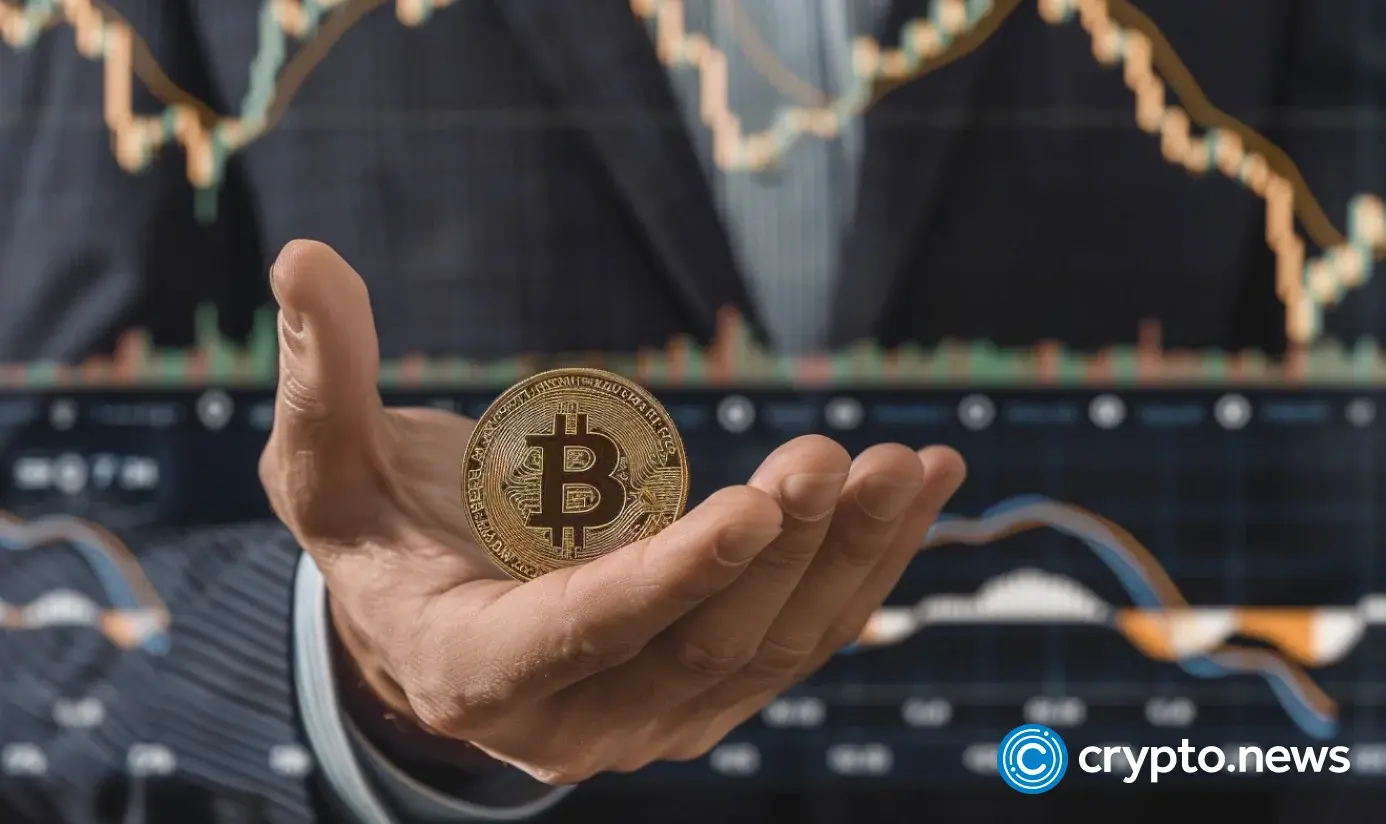
Ten years after its collapse, the Mt. Gox crypto exchange finally began paying off creditors. What is the reason for this process, which has dragged on for a decade?
Let’s dive deep into the chronology of events associated with the fall of one of the once-largest crypto exchanges.
The emergence of Mt. Gox
The history of Mt. Gox goes back to the early days of the crypto industry. It all started in 2010 when developer Jed McCaleb founded the Mt. Gox platform for the Magic: The Gathering game, but then transformed it into a Bitcoin exchange.
A year later, he sold the platform to developer Mark Karpeles. After the change in management, Mt. Gox quickly became one of the most popular BTC platforms.
As a result, the first major hacker attack occurred in June 2011. Hackers stole at least 25,000 BTC, or about $400,000, at the time of the attack. Then, the price of Bitcoin on Mt. Gox collapsed from $17 to almost zero.
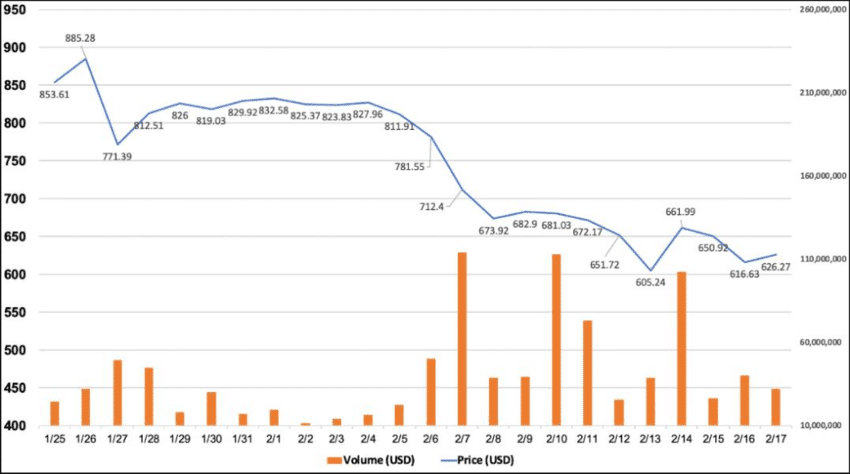
After the attack, Mt. Gox continued to develop, and in 2013, it processed 70% of all Bitcoin transactions worldwide. However, the exchange faced technical problems that led to a significant increase in transaction processing time.
Internal difficulties and hack of Mt. Gox
Despite external success, the exchange experienced great internal difficulties. In particular, Mt. Gox had no control over the quality and security of the code. In addition, the project lacked a financial accounting system and control over balances and reserves. Simply put, no one monitored the flow of money and cryptocurrency.
In February 2014, Mt. Gox suddenly stopped Bitcoin withdrawals. The platform team reported that a bug in the Bitcoin code made it possible to effectively double-spend coins, which the attackers used concerning the exchange’s blockchain address. After that, the platform finally stopped all withdrawals.
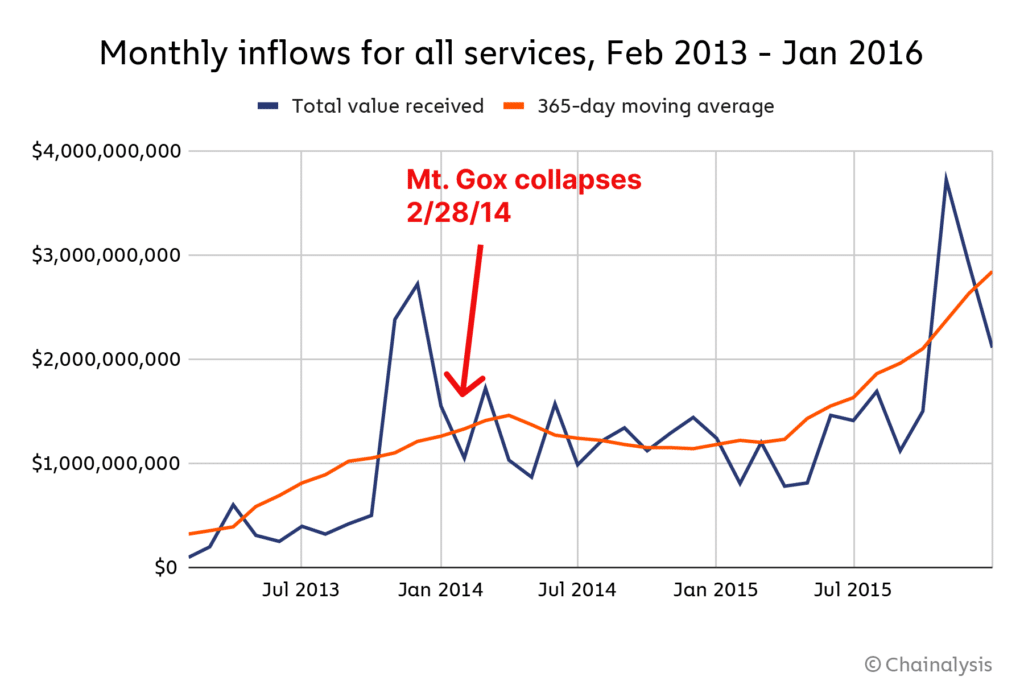
By the end of the month, the price of Bitcoin on Mt. Gox was only 20% of the average market price, which was a clear indication of investors’ confidence that the project would not be able to solve the problems that had arisen. On Feb. 24, 2014, all trading operations were suspended on the platform, and a few hours later, its website went down.
Later, the exchange team discovered the theft of approximately 750,000 BTC from users, which had gone unnoticed for several years. As a result, Mt. Gox became insolvent — on Feb. 28, 2014, it declared bankruptcy and closure.
The hack extent and the mystery of missing Bitcoins
Hackers attacked Mt. Gox and stole 744,408 BTC belonging to customers and 100,000 BTC belonging to the company. This financial disaster led to the exchange being declared insolvent. Later sources indicated that Mt. Gox had already leaked around 80,000 Bitcoins before Karpeles bought it in 2011.
Many theories have formed around the hack. One popular theory suggests that Mt. Gox never actually had the amount of coins it claimed to have and that Karpeles may have manipulated the data to create the illusion of more bitcoins than it had.
As for how the hackers were able to gain access, some speculate that an internal staff member could have gained access. In contrast, others suggest that BTC from the cold storage was gradually transferred to the Mt. Gox system as the hot wallet was depleted. The lack of proper controls allowed the hackers to siphon the assets undetected.
Protracted litigation
From 2014 to 2020, litigation and civil rehabilitation took place. This civil rehabilitation process typically takes three to five years but offers a fairer and more efficient solution for returning assets to affected creditors.
At the same time, the Kraken crypto exchange did not complete the process of collecting and analyzing creditor claims until May 2016. 24,750 users submitted claims for payments.
As a result, the court approved the compensation plan only in early 2021. Then, the exchange’s trustees repeatedly postponed the payment of compensation to creditors, sometimes by a year. They cited technical and administrative delays, including finding the missing BTC and organizing the process of assessing and satisfying creditors’ claims.
Compensations and the impact of the Mt. Gox collapse
The collapse of Mt. Gox was one of the most significant attacks in the crypto industry. The event showed the importance of protecting cryptocurrency platforms and became the starting point for forming legal norms for the entire industry.
On July 5, the exchange’s trustees officially confirmed that they were starting to pay out compensation in Bitcoin and Bitcoin Cash, totaling about $9 billion.
Bitcoin compensation is distributed through the Kraken, Bitstamp, BitGo, and Japanese Bitbank exchanges. According to their agreement terms, they will have several weeks on average to transfer funds to customers. However, when the first batch of coins was moved to Bitbank, its clients began reporting that they had received the funds the same day.
The crypto market participants are concerned about the size of the total compensation and the possible selling pressure on the price of Bitcoin. It is assumed that clients may sell a significant portion of the coins after compensation on the open market.
Against the backdrop of the news, the Bitcoin rate fell below $54,000 in early July—the lowest rate since February 2024. However, by the time of writing, BTC had regained its position, having consolidated at $65,000.
Can the Mt. Gox story repeat?
The crypto industry needs to develop new solutions that combine decentralized technologies’ security with centralized platforms’ efficiency and convenience. However, the Mt. Gox saga cannot be guaranteed to repeat itself.
On one hand, the major crypto exchanges are relatively transparent, offer insured deposits, and are backed by influential venture capitalists. However, many smaller and lesser-known exchanges operate with little transparency.
Source link
You may like
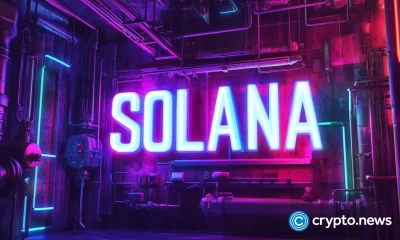

Solana beats Ethereum in a key metric 3 months in a row


SCENE’s 2024 Person of the Year: Iggy Azalea


BTC Risks Falling To $20K If This Happens


Most Layer 2 solutions are still struggling with scalability


Here’s why Stellar Price Could Go Parabolic Soon
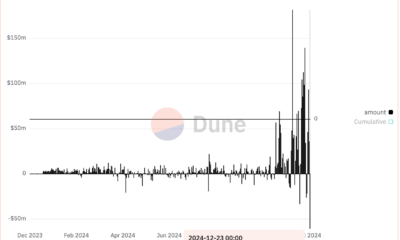

Perp-Focused HyperLiquid Experiences Record $60M in USDC Net Outflows
Bankruptcy
The FTX Co-Founder Proved Assistance to the US Authorities
Published
1 month agoon
November 14, 2024By
admin

FTX co-founder Gary Wang, convicted of misusing funds at a fictitious crypto exchange, may face punishment after his case goes to trial.
On Nov. 13, prosecutors in the U.S. District Court for the Southern District of New York filed a brief alleging that Wang provided significant assistance in the investigation of crimes related to FTX, as well as in the prosecution of Sam Bankman-Fried and several other cases.
The government’s attorneys noted the importance of Wang’s testimony at the trial of Bankman-Fried, who was sentenced to 25 years. They also suggested that if Judge Lewis Kaplan decides to sentence Wang, he could develop a tool to identify potential illegal activities in the crypto market. Prosecutors noted that Wang’s testimony was truthful and corroborated by other evidence.
“Wang has also provided substantial assistance – and in the process taken steps to right past wrongs – by putting his extraordinary computer programing skills to use in detecting potential fraud in the stock and cryptocurrency markets.”
Court filing
Wang, who pleaded guilty to wire fraud, commodities fraud, and securities fraud in December 2022, is awaiting final sentencing on Nov. 20.
Is the FTX story nearing its end?
The latest updates would make Wang the fifth and final FTX or Alameda Research executive to face sentencing. Bankman-Fried was the only one to plead not guilty. In contrast, former Alameda CEO Caroline Ellison and FTX Digital Markets co-CEO Ryan Salame pleaded guilty. All of them are currently serving federal prison sentences.
However, the Bankman-Fried case has continued to see new details and court cases emerge, even as the founder of one of the world’s once-largest exchanges is serving his time in prison.
Meanwhile, Bankman-Fried’s assets are under threat
Earlier, U.S. prosecutors filed a lawsuit seeking to seize cryptocurrency, which they say Bankman-Fried used to bribe Chinese officials.
The lawsuit, filed on Nov. 12 in New York District Court, alleges that a Binance account, then worth about $8.6 million but later growing to about $18.5 million, was used to launder money related to bribes before FTX collapsed in late 2022.
Prosecutors noted that in 2021, Chinese authorities froze two Alameda Research accounts on Chinese exchanges that held $1 billion in cryptocurrency. Later, on Nov. 16, 2021, Bankman-Fried was recorded transferring $40 million to a personal wallet, after which the Alameda accounts were unfrozen. Prosecutors allege that Bankman-Fried initiated additional transactions worth tens of millions of dollars in cryptocurrency to complete the bribe.
“As a result of the Investigation, the Government learned that on or about November 16, 2021, at Bankman-Fried’s direction, approximately 40 million USDT (the “Bribe Payment”) was transferred from an Alameda cryptocurrency wallet hosted by FTX.”
Court filing
The account contained five linked deposit accounts, obscuring the origin of the bribe funds. They described a “flood” of deposits and withdrawals from the account and regular transfers of Bitcoin (BTC) and stablecoins to five wallets. Ellison testified that the total amount of bribes was about $150 million.
Bankman-Fried was initially charged with additional charges related to financial fraud and bribery of foreign officials, which were later dropped. On Sept. 13, his defense team filed an appeal, arguing that Bankman-Fried’s trial was unfair.
Meanwhile, the new FTX management is bombarded with lawsuits
FTX’s new management, meanwhile, is once again preparing lawsuits and demanding money. This time from Binance.
FTX bankruptcy trustees have filed a lawsuit against Binance and its former CEO, Changpeng Zhao, demanding a return of about $1.8 billion. The plaintiffs claim that Binance obtained the funds in a fraudulent transaction in 2021.
According to court documents, FTX and its trading subsidiary Alameda Research were probably insolvent from the start and were certainly insolvent on their balance sheets by early 2021. Therefore, the plaintiffs allege that the share buyback deal was fraudulent.
The lawsuit is one of many filed by FTX and Alameda against their former investors, affiliates, and customers as part of the bankruptcy case. On Nov. 9, the companies filed 23 lawsuits. Among them are claims against U.S. exchange Crypto.com and the political group FWD.US founded by Mark Zuckerberg.
FTX has also filed claims against Anthony Scaramucci and his hedge fund, SkyBridge Capital. The exchange’s lawyers claim that in 2022, Bankman-Fried invested $67 million in various SkyBridge projects since Scaramucci was “seeking financial assistance.” However, these investments “brought virtually no benefit,” the plaintiffs say. According to court documents, FTX is now trying to recover more than $100 million in damages from the company.
Alameda has also filed a lawsuit against Sasha Ivanov, the founder of the Waves blockchain. The company intends to return the $90 million invested in Vires Finance. This liquidity platform then operated on Waves.
“To divert attention from his involvement in the fraud, Ivanov attempted to publicly blame Alameda for destabilizing the Waves ecosystem, tweeting that Alameda had manipulated the WAVES price and organized FUD (“Fear, Uncertainty, and Doubt”) campaigns to trigger panic selling.”
Alameda lawsuit
And what’s next?
In general, the history of the FTX and exchange executives are two different stories. While the platform executives serve their sentences, FTX creditors are frantically trying to return the money they wasted.
The debt to creditors is about $11.2 billion, and the funds available to cover the debt is $14.6-16.3 billion.
Thus, there is very little time left before the end of the scandalous exchange story – to decide on punishment for Wang and repay everyone’s debts.
Source link
Bankruptcy
Here’s how Bitcoin reserves have changed since FTX collapse
Published
1 month agoon
November 10, 2024By
admin
November marks two years since the FTX exchange went bankrupt. Since then, major crypto exchanges have seen their Bitcoin reserves grow.
FTX’s inability to maintain sufficient reserves to meet user requests exposed severe flaws in its controls. It also highlighted the need for greater transparency and reliable reserve reporting among all crypto exchanges.
Observers have grown keenly aware of the risks that exchanges face when they lack sufficient reserves. If they cannot meet withdrawal requests, it undermines user confidence and puts them at risk of losing funds. Maintaining adequate reserves is critical for liquidity and order execution, especially during volatile periods.
In light of this trend, CryptoQuant shared with crypto.news a study on the state of exchange proof-of-reserves (PoR).
How has crypto changed post-FTX?
FTX‘s collapse in November 2022 was one of the most significant and dramatic events in the crypto industry’s history. This incident undermined investor confidence and caused profound changes in the crypto market’s structure and functioning.
At the time, the price of Bitcoin (BTC) and other major cryptocurrencies fell, reflecting fear and distrust of institutional players in the market. Many investors began to doubt the safety and stability of crypto and, as a result, decided to leave the market completely.
Attention toward security issues became even more urgent. Many crypto exchanges and projects have begun implementing new measures to protect users’ funds, including two-factor authentication, monitoring systems, and analyzing transactions for suspicious activity.
New security standards have emerged, as well as solutions to prevent the loss of funds in case of hacks or fraudulent activities. Among others, the PoR standard has emerged — a mechanism cryptocurrency exchanges use to publicly demonstrate that they have enough assets in reserve to cover all user balances.
“PoR fosters trust and transparency, as it allows users to confirm that an exchange has not over-leveraged or mismanaged their assets, which has become particularly crucial following high-profile exchange collapses in the industry.”
CryptoQuant
Major exchanges record Bitcoin outflow
Among the major exchanges with the most prominent Bitcoin reserves, only Coinbase does not publish PoR reports. Experts note that the other major exchanges periodically provide such reports with varying degrees of transparency.
Binance’s reserve increased by 28,000 BTC, or 5%, reaching 611,000, despite the pressure from the U.S. authorities in 2023. Among the major exchanges, Binance also shows the most minor reserve decrease over the entire period, not exceeding 16%.
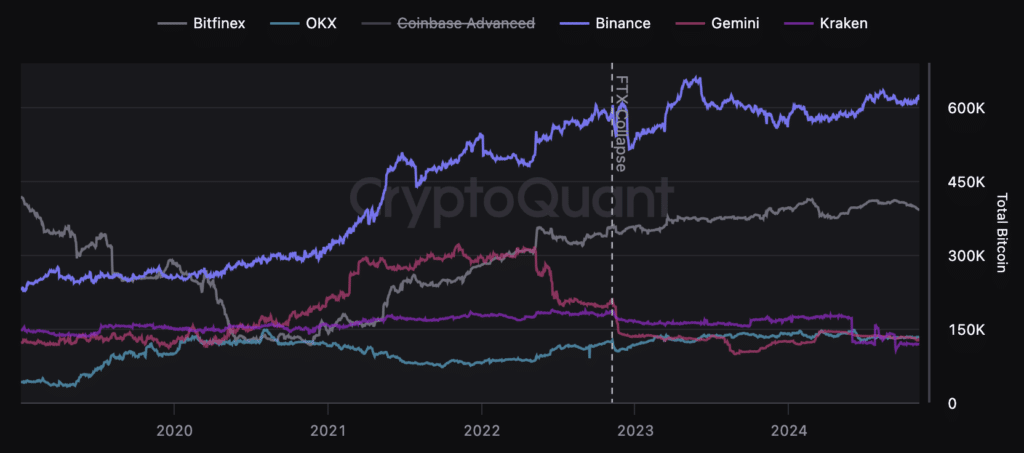
Three key exchanges hold 75% of all Bitcoins held by exchanges. These are Coinbase Advanced, with 830,000 BTC, Binance with 615,000, and Bitfinex, which has 395,000 Bitcoins.
Together, the reserves of these platforms reach 1.836 million BTC, which is 9.3% of the total amount of Bitcoins in circulation. The remaining 17 exchanges hold a total of 684,000 BTC.
Reserves landing
Currently, Binance, Bitfinex, and OKX show small decreases in reserves. At the same time, Binance appears to be the only exchange that has not experienced significant drawdowns in its history.
Analyzing exchange reserves based on tracking their changes allows us to assess their ability to meet user demands over time.
Significant declines may indicate that users are massively withdrawing their funds, indicating a decrease in trust or financial problems.
The most significant decline in Binance’s reserves was 15%, which occurred in December 2022, shortly after the FTX crash. At the time, Binance faced considerable criticism and distrust over its reserve report.
However, Binance’s reserves have recovered and are currently down only 7%. Other significant exchanges have also seen slight declines, with Bitfinex down 5% and OKX down 11%.
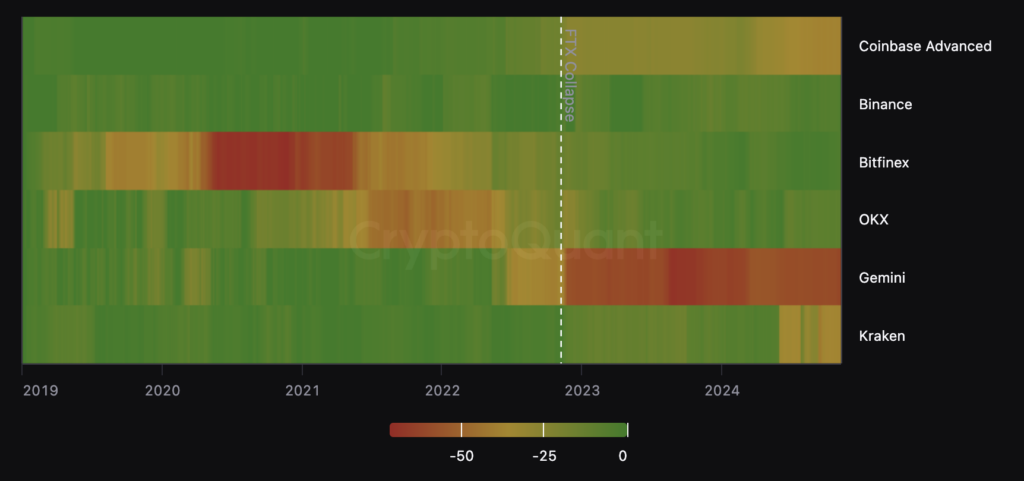
While industry leaders like Binance and Bitfinex have managed to shore up their reserves since the FTX crash, the situation is still tense. The failure of some major players like Coinbase to publish PoR reports suggests that the road to full transparency is still far off. But the current reserve dynamics indicate a desire to improve and increase users’ trust.
The expert, in a comment to crypto.news, emphasized that the bankruptcy of FTX underscored the need for crypto exchanges to prove that they have enough reserves.
“This event led to a shift where users prefer exchanges that show proof of their assets on-chain. This pushed the industry to adopt PoR practices, helping rebuild trust and ensure exchanges can back up their users’ funds.”
Nick Pitto, head of marketing at CryptoQuant
Source link
Bankruptcy
Delaware Judge Approves FTX Estate’s Bankruptcy Plan
Published
3 months agoon
October 7, 2024By
admin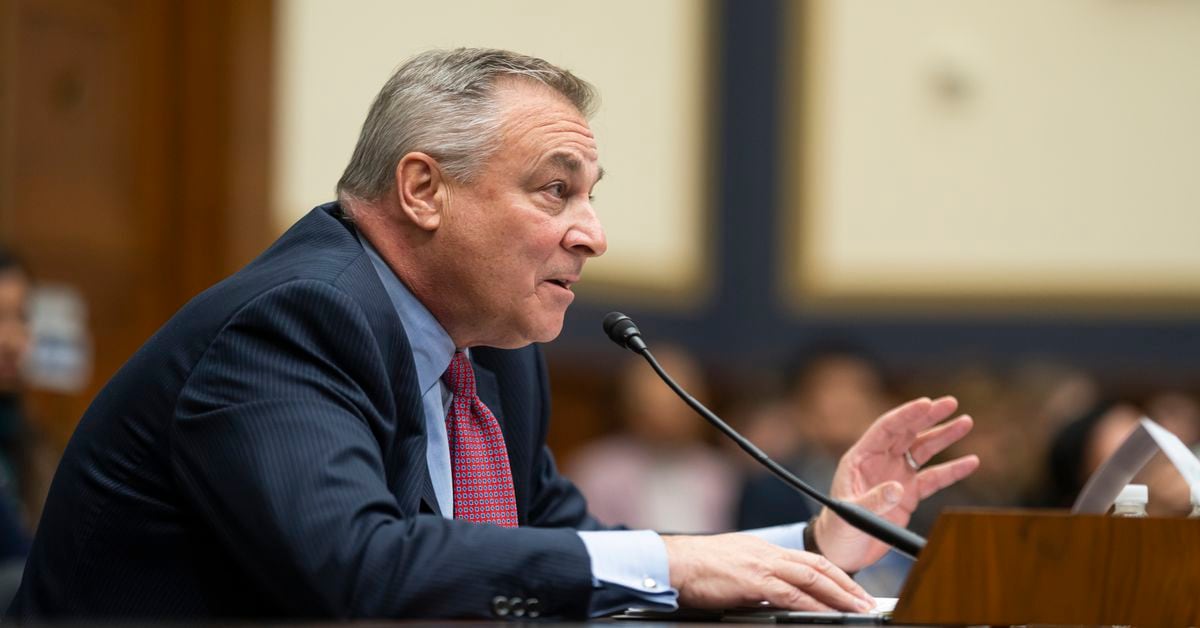

A U.S. court approved FTX’s bankruptcy plan on Monday, which will see the majority of the crypto exchange’s customers get the equivalent of their 2022 losses, and then some.
Source link

Solana beats Ethereum in a key metric 3 months in a row

SCENE’s 2024 Person of the Year: Iggy Azalea

BTC Risks Falling To $20K If This Happens

Most Layer 2 solutions are still struggling with scalability

Here’s why Stellar Price Could Go Parabolic Soon

Perp-Focused HyperLiquid Experiences Record $60M in USDC Net Outflows

Experts say these 3 altcoins will rally 3,000% soon, and XRP isn’t one of them

Robert Kiyosaki Hints At Economic Depression Ahead, What It Means For BTC?

BNB Steadies Above Support: Will Bullish Momentum Return?

Metaplanet makes largest Bitcoin bet, acquires nearly 620 BTC

Tron’s Justin Sun Offloads 50% ETH Holdings, Ethereum Price Crash Imminent?

Investors bet on this $0.0013 token destined to leave Cardano and Shiba Inu behind

End of Altcoin Season? Glassnode Co-Founders Warn Alts in Danger of Lagging Behind After Last Week’s Correction

Can Pi Network Price Triple Before 2024 Ends?

XRP’s $5, $10 goals are trending, but this altcoin with 7,400% potential takes the spotlight
182267361726451435

Why Did Trump Change His Mind on Bitcoin?

Top Crypto News Headlines of The Week

New U.S. president must bring clarity to crypto regulation, analyst says

Will XRP Price Defend $0.5 Support If SEC Decides to Appeal?

Bitcoin Open-Source Development Takes The Stage In Nashville

Ethereum, Solana touch key levels as Bitcoin spikes

Bitcoin 20% Surge In 3 Weeks Teases Record-Breaking Potential

Ethereum Crash A Buying Opportunity? This Whale Thinks So

Shiba Inu Price Slips 4% as 3500% Burn Rate Surge Fails to Halt Correction

Washington financial watchdog warns of scam involving fake crypto ‘professors’

‘Hamster Kombat’ Airdrop Delayed as Pre-Market Trading for Telegram Game Expands

Citigroup Executive Steps Down To Explore Crypto
Mostbet Güvenilir Mi – Casino Bonus 2024

NoOnes Bitcoin Philosophy: Everyone Eats
Trending

 3 months ago
3 months ago182267361726451435

 Donald Trump5 months ago
Donald Trump5 months agoWhy Did Trump Change His Mind on Bitcoin?

 24/7 Cryptocurrency News4 months ago
24/7 Cryptocurrency News4 months agoTop Crypto News Headlines of The Week

 News4 months ago
News4 months agoNew U.S. president must bring clarity to crypto regulation, analyst says

 Price analysis4 months ago
Price analysis4 months agoWill XRP Price Defend $0.5 Support If SEC Decides to Appeal?

 Opinion5 months ago
Opinion5 months agoBitcoin Open-Source Development Takes The Stage In Nashville

 Bitcoin5 months ago
Bitcoin5 months agoEthereum, Solana touch key levels as Bitcoin spikes

 Bitcoin5 months ago
Bitcoin5 months agoBitcoin 20% Surge In 3 Weeks Teases Record-Breaking Potential


